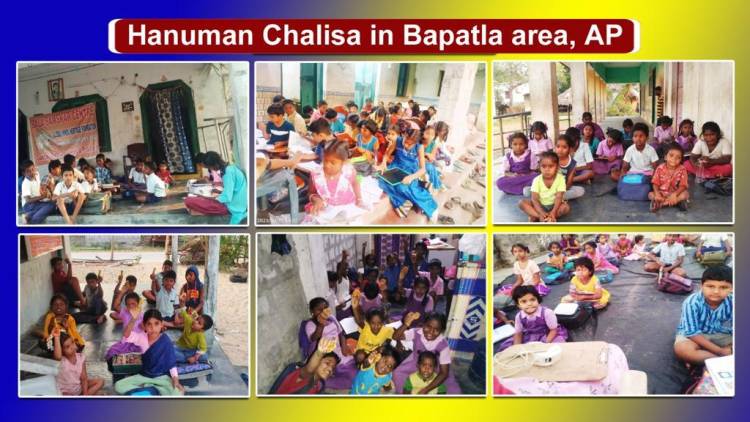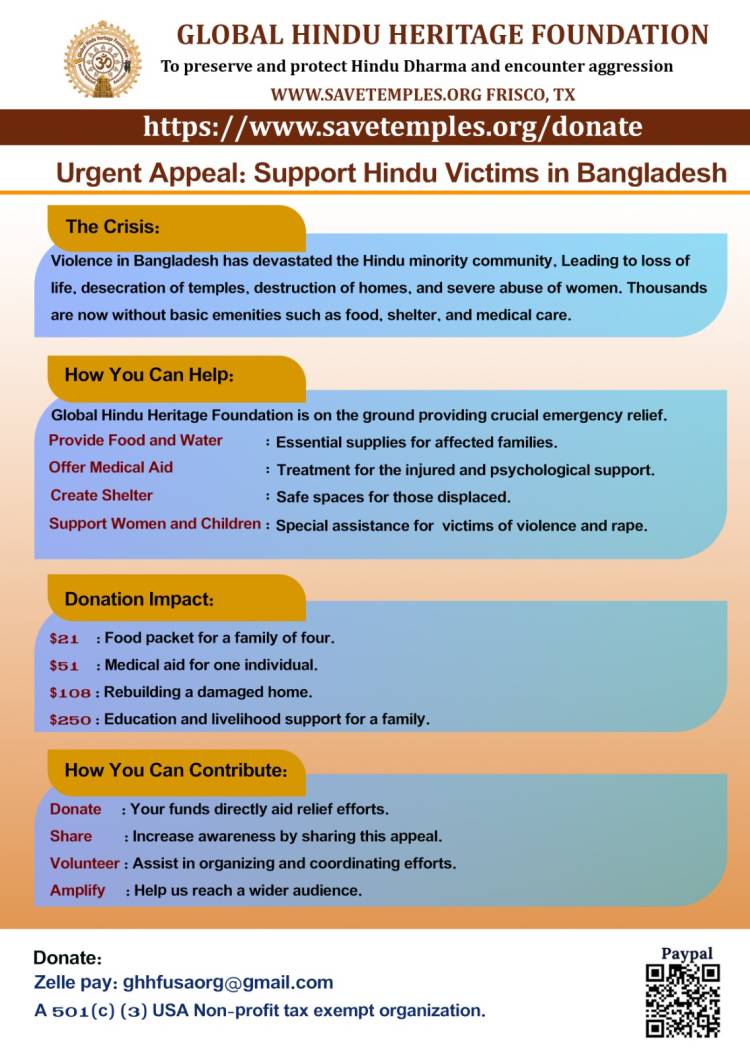[GHHF] Bala Samskar Kendras in Bapatla – Teachers are teaching 2 verses at a time of Hanuman Chalisa “The character of Lord Rama is a beautiful Chintamani and a beautiful adornment of the wisdom of saints. The group of qualities of Lord Rama is the doer of the world and the giver of liberation, wealth, religion, and supreme abode.” –
 Ramayana Quotes
Ramayana Quotes
Global Hindu Heritage Foundation is very happy to inform you that we have started Bala Samskar Kendras (Schools for children and youth) to enrich them with the greatness of Hindu Dharma and appreciate the sacrifices many leaders have done to protect Bharat. There are many kings who have achieved new heights in their skills, talents, and strength. Unfortunately, Bharath denies its history to its own children and glorified the most undeserving rulers. The government has corrupted the minds of young students since Independence from 1947. It is our effort to teach them the greatness of our scriptures, enrich their minds with timeless wisdom, create a sense of pride through time-tested moral and ethical compass, and make them proud of the science behind all our customs and traditions.
Bala Samskar Kendras started in January 2023 and now we have 8 Bala Samskar Kendras. They are very active and large number of children are attending and many parents are impressed with their own children and how much they are learning and how they changed behaviorally. Students were taught to chant Hanuman Chalisa.
Learning Hanuman Chalisa Verses
Sant Tulsidas, also known as Goswami Tulsidas (1532–1623) was a Hindu Vaishnava saint and poet, often called reformer and philosopher. Tulsidas wrote several popular works in Sanskrit and Awadhi; he is best known as the author of the epic Ramcharitmanas, a retelling of the Sanskrit Ramayana based on Rama's life in the vernacular Awadhi dialect of Hindi. The Bhavishya Purana also predicts the incarnation of Shri Valmiki as Goswami Tulsidas in the Kaliyuga, in its verse and also explained in detail by H.G Shriman Chandra Govind Das of the Iskcon Temple.
Tulsidas spent most of his life in the city of Varanasi. The Tulsi Ghat on the Ganges River in Varanasi is named after him. He founded the Sankatmochan Temple dedicated to Hanuman ji in Varanasi, believed to stand at the place where he had the sight of Hanuman ji. Tulsidas started the Ramlila plays, a folk-theatre adaption of the Ramayana.
He has been acclaimed as one of the greatest poets in Hindi, Indian, and world literature. The impact of Tulsidas and his works on the art, culture and society in India is widespread and is seen to date in vernacular language, Ramlila plays, Hindustani classical music, popular music, and television series
With the help of Lord Hanuman, Tulasidas was able get the darshan of Lord Rama. Rama told him,“ My son, your love alone has brought me here. You are truly blessed. From now on you shall be known as Tulsidas. It is your duty to write the story of the Ramayana in simple language that the common people can understand.” Tulsidas was astounded, “My Lord!” he said. “I am totally incapable of writing on such a great subject. All I know is to chant your name. How can I fulfill your command?” Rama looked lovingly at him and said, “Fear not. You will be given guidance by Hanuman, who is not only erudite but also filled with devotion. He has been a living witness to the story of my life. He is the best person to guide you.” Thus, it happened that Tulsidas started writing the Ramayana in the common man’s language, Awadhi, which was a dialect of Hindi. It was written in the year AD 1575.
Many miracles were attributed to Tulsidas. Hearing about these, the Mogul emperor Akbar sent for him and asked him to perform a miracle for him. Tulsidas replied, “I am only a humble servant of Rama. He alone is the worker of miracles.” “Show me your Rama, then,” said the emperor. Tulsidas remained silent. The emperor became angry at his silence and ordered him to be put in jail. It is said that Tulsidas composed the Hanuman Chalisa when he was in prison at Fatepur Sikri, which was Akbar’s fortress at the time. During those forty days when he was composing the verses, he prayed to Hanuman to save him from this predicament. At the end of the forty days, the whole of the emperor’s fort was swarming with monkeys. They clawed people, tore their clothes, entered houses, and destroyed gardens. At last the emperor realized that this must be the work of the man he had thrown in jail. He ran to him and fell at his feet, begging him to order the monkeys to go away.
It is known as Hanuman Chalisa because it consists of 40 verses in praise of Lord Hanuman. The Hanuman Chalisa is believed to bring blessings and protection to those who recite it with faith and devotion. It is believed that reciting the Hanuman Chalisa helps in invoking the blessings of Lord Hanuman and can bring peace, prosperity, and happiness to the devotee.
Bala Samskar teachers are teaching the students to learn 2-4 verses per class. They may be repeated until they learn those verses before they move on to next set of verses.
Jai Hanuman gyan gun sagar, Jai Kapis tihun lok ujagar
Victory to thee, O'Hanuman! Ocean of Wisdom-All hail to you O'Kapisa! (fountain-head of power,wisdom and Shiva-Shakti) You illuminate all the three worlds (Entire cosmos) with your glory.
Ram doot atulit bal dhama, Anjani-putra Pavan sut nama
You are the divine messenger of Shri Ram. The repository of immeasurable strength, though known only as Son of Pavan (Wind), born of Anjani.
DONATIONS
PayPal Method: To donate visit our website: savetemples.org. Click on the Donate button, then press the Purpose category, and select the General Donation category.
By Check: Or you can send a check payable to: GHHF, It is tax-deductible.
By Zelle: ghhfusaorg@gmail.com
By Rupees, please contact us by either phone or email.
For more information, call Prakasarao V Velagapudi 601-918-7111 ; Email: ghhfusaorg@gmail.com
















 Urgent support needed for Bangladesh Hindus
Urgent support needed for Bangladesh Hindus  GHHF Gala Dinner - 2024. Nov 16th @6PM in Frisco, USA
GHHF Gala Dinner - 2024. Nov 16th @6PM in Frisco, USA 







